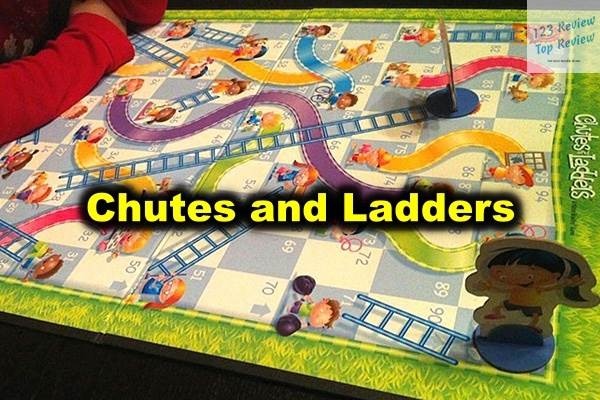With its simple mechanics, vibrant design, and underlying educational value, the Chutes and Ladders game offers more than just entertainment; it provides lessons in counting, patience, and even moral behavior.

In this article, 123 Review will take a closer look at the history, gameplay mechanics, educational benefits, and overall user experience of Chutes and Ladders, as well as how it compares to other classic board games. Whether you’re a parent introducing the game to a new generation or someone revisiting a childhood favorite.
History of Chutes and Ladders
Origins in Ancient India
The origins of Chutes and Ladders can be traced back to ancient India, where it was known as Moksha Patam, a game steeped in spirituality and moral instruction. Moksha Patam was more than just a leisure activity; it was a representation of the philosophical concepts of karma and moksha, or liberation. The ladders in the game symbolized virtues like humility, generosity, and faith, which would elevate a person’s soul closer to nirvana. On the other hand, the snakes represented vices such as anger, theft, and lust, leading the player downward, away from salvation. The game was a reflection of life’s journey, with its ups and downs, and the ultimate goal was to reach spiritual enlightenment.
Evolution into Snakes and Ladders
As the game spread to different regions, it evolved into what we now know as Snakes and Ladders. The game was brought to England in the 19th century by British soldiers and officials returning from colonial India. While the moral and religious connotations were somewhat diluted in this new context, the core mechanics of the game remained the same. The snakes and ladders were retained, but the game was now seen more as a form of entertainment rather than a spiritual journey. The game became widely popular in Victorian England, where it was embraced as a parlor game for children, teaching them about the rewards of good behavior and the consequences of bad actions, albeit in a more secular context.
Introduction to the United States
In the 1940s, the game was introduced to the United States by the Milton Bradley Company, a major player in the American board game industry. Recognizing the potential appeal of the game to American families, Milton Bradley made a significant modification: replacing the snakes with chutes. This change was made to make the game more palatable and child-friendly, as chutes (or slides) were considered less frightening than snakes. Thus, Chutes and Ladders was born. The game was an instant hit in the U.S., quickly becoming a staple in American households. Its straightforward gameplay, combined with the thrill of climbing ladders and the suspense of sliding down chutes, resonated with children and parents alike, solidifying its place in American culture.
Gameplay Mechanics
Game Components
The standard Chutes and Ladders game board is a 10×10 grid consisting of 100 numbered squares. Each square is decorated with colorful illustrations, often depicting scenes of children engaging in various activities, such as helping others or causing trouble. These illustrations serve as visual cues, correlating with the concept of advancing up ladders or sliding down chutes. The game also includes a set of player tokens, usually in the form of small, colorful plastic figures, and a spinner or die, which players use to determine the number of spaces they move on their turn.
Setup Instructions
Setting up Chutes and Ladders is quick and simple, making it an ideal choice for impromptu game sessions. To start, each player selects a token and places it on the starting square, labeled as number 1. The spinner or die is placed in the center of the table, accessible to all players. The game can accommodate 2 to 4 players, though some versions allow for more. Once all players are ready, the game begins with the first player spinning the spinner or rolling the die, and then moving their token forward by the number of spaces indicated.
Basic Rules of Play
The rules of Chutes and Ladders are refreshingly simple, which is one of the reasons it’s such a popular game for young children. Players take turns spinning the spinner or rolling the die, then move their token the corresponding number of spaces on the board. If a player lands on the bottom of a ladder, they immediately climb up to the square at the top of the ladder. Conversely, if they land on a square with the top of a chute, they slide down to the square at the bottom. The game proceeds in this manner until one player reaches the final square, number 100.
Winning Conditions
The objective of Chutes and Ladders is to be the first player to reach the 100th square. However, the journey to the top is filled with potential setbacks. If a player’s spin or roll would move them beyond square 100, they must remain on their current square and wait for their next turn. The first player to land exactly on square 100 wins the game. This rule adds an element of suspense to the final moments of the game, as players may find themselves just short of victory, only to be sent sliding down a chute on their next turn.
Educational Benefits
Teaching Counting and Colors
Chutes and Ladders is more than just a game of chance; it’s also a valuable educational tool, particularly for preschool-aged children. The game’s format naturally encourages players to practice counting, as they move their tokens from one square to the next. Each spin or roll offers an opportunity to reinforce basic numeracy skills. Additionally, the game board is a riot of colors, with each square vividly illustrated. This makes it an excellent resource for teaching color recognition and helping children differentiate between various hues.
Promoting Good Behavior
At its core, Chutes and Ladders retains the moral lessons of its ancient predecessor, Moksha Patam. The ladders in the game represent rewards for good deeds, such as helping others or being polite, while the chutes symbolize the consequences of negative behavior, like being mean or irresponsible. This aspect of the game provides a gentle way to introduce young children to the concepts of cause and effect, and the importance of making good choices. While playing, children learn that good behavior leads to progress (climbing a ladder), while bad behavior can result in setbacks (sliding down a chute).
Variations of the Game
Themed Editions
Over the years, Chutes and Ladders has been reimagined in a variety of themed editions to appeal to different audiences. These versions often feature beloved characters from popular movies, TV shows, and books. For example, there are editions of Chutes and Ladders featuring characters from “Toy Story,” “Dora the Explorer,” and “Super Mario.” These themed versions not only keep the game fresh and exciting but also help introduce the classic gameplay to new generations of players. While the core mechanics remain the same, the familiar characters and settings provide an added layer of enjoyment, especially for younger children who may be fans of the featured franchises.
Digital Versions
In the digital age, Chutes and Ladders has also made its way onto screens, with several mobile apps and online versions available. These digital adaptations often come with enhanced features, such as animated sequences, sound effects, and multiplayer options that allow players to compete against friends or family members remotely. Some versions also include additional game modes, challenges, and even educational mini-games, further extending the play value. While the digital versions maintain the charm and simplicity of the original board game, they offer a more interactive experience, appealing to tech-savvy children and families.
User Experience
Age Suitability and Accessibility
Chutes and Ladders is designed with young children in mind, typically recommended for ages 3 and up. The game’s simple rules and lack of reading requirements make it accessible to preschoolers, while older children can also enjoy it as a quick and fun diversion. The game is also easy to set up and play, with minimal supervision required, making it an ideal choice for family game nights or playdates. The bright colors, engaging illustrations, and straightforward gameplay ensure that even the youngest players can participate and have fun, fostering a sense of inclusion and shared enjoyment.
Family Bonding and Nostalgia
One of the most enduring appeals of Chutes and Ladders is its ability to bring families together. The game’s easygoing nature allows for casual play, where parents and children can enjoy time together without the pressure of complex rules or intense competition. For many adults, playing Chutes and Ladders with their children is a nostalgic experience, evoking memories of their own childhoods. This connection between generations adds a layer of emotional resonance to the game, making it more than just a pastime—it becomes a cherished tradition, passed down through the years.
Strategy Tips
Utilizing Ladders and Chutes Effectively
While Chutes and Ladders is largely a game of luck, there are a few strategies that players can employ to improve their chances of winning. Understanding the layout of the board and the placement of the ladders and chutes can help players anticipate potential moves and plan accordingly. For instance, certain squares offer a higher likelihood of landing on a ladder, providing a shortcut to the top. Similarly, players can be mindful of squares that precede a chute, attempting to avoid them if possible. Although these strategies may not guarantee a win, they can add an element of tactical thinking to the game, making it more engaging for older players.
Managing Moves and Turns
Another strategy involves managing moves and turns more carefully. Since players must land exactly on square 100 to win, it’s important to consider the number of spaces left and the potential outcomes of each spin or roll. For example, if a player is close to the end but risks overshooting square 100, they might choose to play conservatively, hoping for a lower number on their next turn. Conversely, a player further from the finish might take more risks, aiming for a ladder that could propel them forward. This balance between caution and boldness can add depth to the game, even though chance ultimately plays the dominant role.
Comparison to Other Classic Board Games
Similarities with Candy Land
Chutes and Ladders shares many similarities with another classic children’s game, Candy Land. Both games are designed for young players and feature brightly colored boards, simple rules, and a focus on luck rather than skill. Like Chutes and Ladders, Candy Land involves moving along a linear path with special spaces that either advance or hinder a player’s progress. However, while Chutes and Ladders incorporates the concept of ladders and chutes as metaphors for moral lessons, Candy Land is purely a race to the finish, with its sugary theme appealing to children’s imaginations.
Unique Aspects Compared to Monopoly
While Chutes and Ladders and Monopoly are both beloved board games, they cater to different audiences and offer distinct gameplay experiences. Monopoly, with its focus on real estate, money management, and strategy, is more suitable for older children and adults. It involves complex rules, decision-making, and negotiation, providing a more competitive and time-consuming experience. Chutes and Ladders, on the other hand, is designed for younger children, with a focus on simplicity and quick gameplay. The two games represent different ends of the board game spectrum: one is a leisurely, chance-based game perfect for family bonding, while the other is a strategic, high-stakes game that can last for hours.
Conclusion: Why Chutes and Ladders Remains a Classic
Chutes and Ladders has stood the test of time because it offers a perfect blend of simplicity, fun, and educational value. Its roots in ancient philosophy give it a unique depth, while its modern iterations make it accessible and engaging for children of all ages. Whether played as a physical board game or in a digital format, Chutes and Ladders continues to be a beloved choice for family game nights, playdates, and solo play. Its ability to teach important lessons while providing endless entertainment ensures that it will remain a staple in homes for generations to come.
Whether you’re a parent looking for a way to bond with your children, an educator seeking a tool for teaching basic skills, or simply a fan of classic board games, Chutes and Ladders is a game that offers something for everyone. Its enduring popularity is a testament to its universal appeal, making it a timeless classic that will continue to delight players for years to come.





